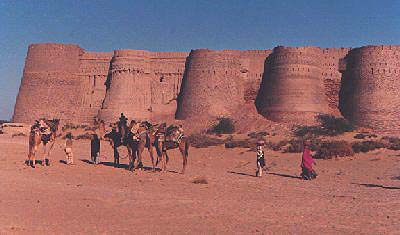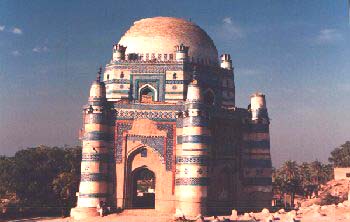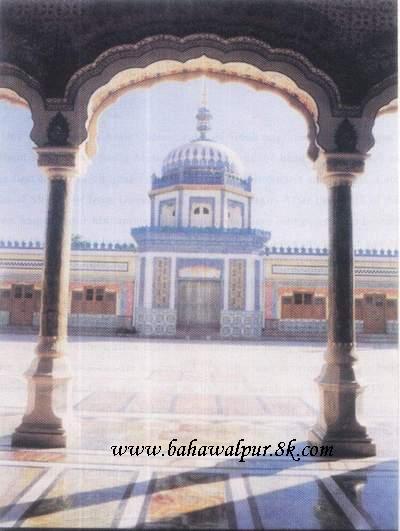|
The Cholistan Desert:
| East of Bahawalpur is the Cholistan Desert
which covers an area of about 15,000 square km and
extends into the Thar Desert of India. The
region was once watered by the Hakra River, known as the Saravati in vedic
times. At one time there were 400 forts in the area and archaeological finds
around the Darawar Fort, the only place with a perennial waterhole, indicate
that it was contemporaneous with the Indus Valley Civilization.The average
annual rainfall is only 12 cm, and the little cultivation there
is, is made possible by underground wells, drawn up by the camels.The water is stored in troughs, built by the tribes, between sand hills
and din waterholes called tobas.The people are racially similar to those in Rajasthan -
tall, with sharp features. They live in large, round, mud and grass huts,
usually built on the top of sand hills. On the whole, they are pastoral and
nomadic. The main tribes are the Chachar, Mehr, Lar, Paryar, Channar, Chandani
and Bohar. |
 |
Darawar Fort:
| The
forts here were built at 29 km intervals, which probably served as guard
posts for the camel caravan routes. There were three rows of these forts.
the first line of forts began from Phulra and ended
in Lera, the second from Rukhanpur to Islamgarh, and the third from Bilcaner to Kapoo.
They are all in ruins now, and you can see that they were built with double
walls of gypsum blocks and mud. Some of them date back to
1000 BC, and were destroyed and
rebuilt many times. |
 |
Uch Sharif
| Uch Sharif, 75 km Eastern from Bahawalpur is avery old town. It
is believed that it existed 500 BC.Some historians believe that Uch was there
even before the advent of Bikramajit when Jains and Buddhist ruled over the
sub-continent. At the time of the invasion by Alexander the Great, Uch was under
Hindu rule. Certain historians say that Alexander came to Uch after
conquering northern parts of India and spent over a fortnight in they city and
renamed it. Alexandria. Some have mentioned Uch by the name of Sikandara or
Iskalanda.They have described it as the most flourishing and beautiful town perched upon the plateau near the confluence of the Chenab and Ravi rivers.
the famous shrines existing at Uch include those of Hazrat Bahawal Haleem,
Hazrat Jalaluddin Surkh Bukhari, Makhdoom Jahanian Jahangasht, Shaikh Saifuddin
Ghazrooni and Bibi Jawanadi. The shrine of Bibi Jawandi is a central
Asian
design, titled in the blue and white faience. |

Uch is a small town today and divided into three
different quarters known as (i) Uch Bukhari, after Hazrat Syed Jalaluddin
Bukhari Surkhposh,(ii) Uch Jilani, after the name of Hazrat Shaikh Mohammad
Ghaus Qadri Jilani (Bandagi), who came from Halab in 887 AH, (iii) Uch Mughlan
after the Mughal rulers. |
Mosque at Bhong:
| Bhong is in the Rahim Yar Khan district and is about 200
km from Bahawalpur. This mosque was built by Rais Ghazi,
a local landlord of Bhong. Gold leaves have been used for the intricate decorative work in the
mosque which has made it famous for its beauty and the stylish calligraphic
work. |
 |
Lal Suhanra National Park:
| This park is ideal for recreation, education or research
but shooting is forbidden. This park, 36 km to the east of Bahawalpur is a
combination of a natural lake and forest on 77480 acres of land and spread over
on the both sides of Bahawalpur canal. It has watch-towers, catching ground,
tourist huts, rest house, camping grounds, TDCP Resort with 6 A/C Bed Rooms and
treks for the visitors and lovers of nature. Hog deer, ravine deer, black buck
and nilgai are common. Fox, jackals, hares,porcupines, mongoose, larks, owls
and hawks are also found. Wild boars are in large number in the forest areas. Lal Suhanra
National Park which is actually a wildlife sanctuary worth a visit. |
![]() |
|
|
|